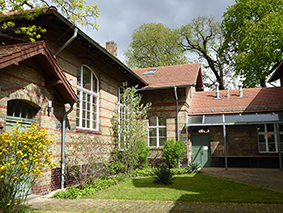BCCN Berlin

The Bernstein Center for Computational Neuroscience Berlin was founded in 2004 and addresses one of the most challenging questions in computational and cognitive neuroscience:
“How is it possible that we can react to sensory stimuli with millisecond precision if intermediate processing elements – on the level of single synapses, single neurons, small networks and even large neural systems – vary significantly in their response to the same repeated stimulus?”
In the first twelve years the Center was financially supported by the Federal Ministry of Education and Research (BMBF). Since 2016 it is a joint research center of Charité, Humboldt-Universität zu Berlin, and Technische Universität Berlin. The newly founded "Interdisciplinary Center Computational Neuroscience" (ICCN) of Humboldt-Universität zu Berlin is supporting the BCCN Berlin. The interdisciplinary research is executed furthermore by groups of the Freie Universität Berlin, Max-Delbrueck-Centrum, and the Universität Potsdam. It is part of the Bernstein Network Computational Neuroscience and financially supported by the three partners Charité, Humboldt-Universität zu Berlin, and Technische Universität Berlin.
The promotion of young researchers is a main concern of the BCCN Berlin and ICCN. Within our international Graduate Program Computational Neuroscience, we aim to train state of the art mathematical and computational skills as well as neuroscientific and clinical methodologies to our master and PhD students.
Julius Bernstein

The Bernstein Network has been named after Julius Bernstein (1835–1917), the German scientist who formulated about hundred years ago his “Membrane Theory” stating that
“the electrical currents observed in many living organs of animals and plants have been the objects of much research. We detect such currents in muscles, nerves, secretory glands, and electric organs of fish as well as in plant tissue (…) It seems likely that all these currents have a similar, if not the same basis, and that their strength and potency depends on the structural conditions and chemical composition of the cells making up each organ.”